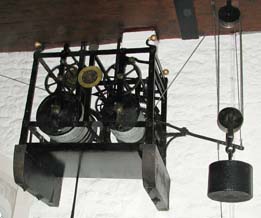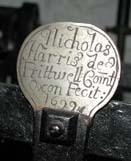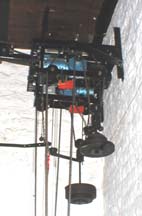
*To view Full screen. Double click the video clip on PC or tap twice on Mobile device
Click to view video clip [1 Min 52 secs]
We gratefully acknowledge the following extract taken from
“CLOCKMAKING IN OXFORDSHIRE by CFCBeeson”
(Museum of history of Science, Oxford, 1967).
In the plain iron bar frame of this William 111 clock the lower horizontal bars are placed so as to leave unusually long legs. The finials are laterally inclined swan-necks ending in spherical "door-knobs."Of the 2 side-by-side trains the going barrel has been replaced by one of much larger diameter and now takes an increased length of wire rope for a 4-sheaf pulley-system. The brass 2nd wheels in both trains are lightly built with 8 straight arms expanded near the rim. A plate is bolted to the escape wheel to reinforce it. Two vertical bars strengthen the frame at the back to support the pendulum cock. The pendulum is an iron rod carrying a heavy lenticular bob beating about one second. Three pairs of pivot-bars are attached by nuts, and on the front of the frame is an extra bar provided with 2 slots permitting it to slide up and down. A lateral projection on this bar rests on the squared arbor of the great wheel and the device presumably works as a maintaining power. In the striking train the fly arbor is offset and the locking-plate is outside the frame. Drive to the dial is taken from a contrate wheel vertically upwards to the storey above.
At the top of the pivot-bar, taking the indicator dial and clutched middle wheel, is a small plaque inscribed, "Nicholas Harris de Fritwell com't Oxon Fecit 1699." (shown in the photo on the right)
The clock is mounted on stout wooden corbels projecting from the wall and is not enclosed in the usual cupboard. It is the oldest Oxfordshire turret clock with a date and the maker's name. The churchwardens' accounts have disappeared and its l8th century history is unknown.
In 2001 we commissioned Gillett & Johnston, clock makers from Croydon, to overhaul the clock and re-gild the dial. A new auto winding mechanism was fitted to replace the lines and weights, which descended through the ringing chamber into the west end of the church below, thereby ending 302 years of winding the clock by hand.
Our Clock keeper - Tower Captain Graham Griffiths says “St. Mary’s clock is now 318 years old. and for such an old clock it keeps remarkably good time. It is accurate to within 30 seconds a week”
St. Marys Church Great Milton has the oldest turret clock in Oxfordshire - dated 1699
Produced by Stefan D’Anger
Post production editor - Graham Griffiths
Click Photos to Enlarge


